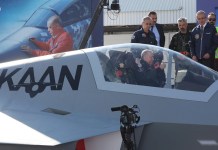Israeli defense firm, Israel Aerospace Industries (IAI), has announced the sales of kamikaze (suicide) drones — Rotem and Harop — to Asian countries in deals worth more than $100 million.
In a press release, the firm revealed deals for Rotem VTOL and the naval and ground-based versions of Harop drones to an unspecified number of countries.
Keeping with the usual policy of Israel of not revealing the customers, IAI stated, “The contracts include winning an international tender for the sale of the multi-purpose ROTEM system to a foreign country, sale of the naval version of the HAROP system to the navy of a country in Asia and sale of the ground version of the HAROP system to another customer in Asia.”
The firm stressed that the contracts prove the commitment of international militaries in these precision munition systems and their effectiveness in combat.
The Rotem-L is one of the world’s only combat-proven recoverable loitering munition capable of carrying EO/IR (Electro-Optical/Infrared) sensors, aiding in both surveillance as well as 1 kg explosive warhead for precision strikes. It is a quadcopter that can loiter for about 30-45 minutes with a maximum range of 10 km.
According to IAI, the Rotem is already in service with many militaries around the world as a small loitering device based on a drone platform and is a “power multiplier” for tactical forces in a range of combat scenarios, including security operations and maneuvers.
The system provides a reconnaissance, observation, and attack envelope with maximum autonomous performance, integrating a simple and intuitive operation interface that can be used by a single fighter from a touchscreen tablet.
The Harop, developed from the IAI’s popular ‘Harpy’ kamikaze drone, is also a loitering munition but with greater range and endurance, with an integral anti-radiation seeker that can autonomously home in into hostile radio emissions. It is also equipped with various electro-optical day/night sensors, having the ability to search, track, and destroy the targets, from any direction and any angle of attack.
Swarms of such drones launched into enemy territory can give a great advantage to the militaries for SEAD (suppression of enemy air defenses) missions, which can loiter the battlefield and attack targets by self-destructing into them, or it can fly safely back to its base for re-use in case the target is not engaged.
The firm has also developed a maritime version of the Harop. “The Maritime HAROP system provides an operational solution for a range of vessels, from off-shore vessels to fighting frigates in the naval theater. In a complex naval theater, the HAROP system gives mission commanders in a fleet of ships the capability to independently and organically collect intelligence, assess targets, and strike.
“The intelligence gathered by the HAROP is directly integrated into the vessel’s control room and allows for quick, accurate, and lethal decision-making. Use of the HAROP on naval platforms is an operational alternative and complementary element to using sea-sea missiles, with a wide range of uses and with optimal cost-efficiency for the navy,” the company says.
Such loitering munitions are in high demand with many militaries around the world. While China has shown the world’s first operational kamikaze swarm drone capability, and the United States being the first to bring on the trend of hunter-killer UAVs, the future of air combat could be dominated with the use of drones with less human interference.
Follow EurAsian Times on Google




